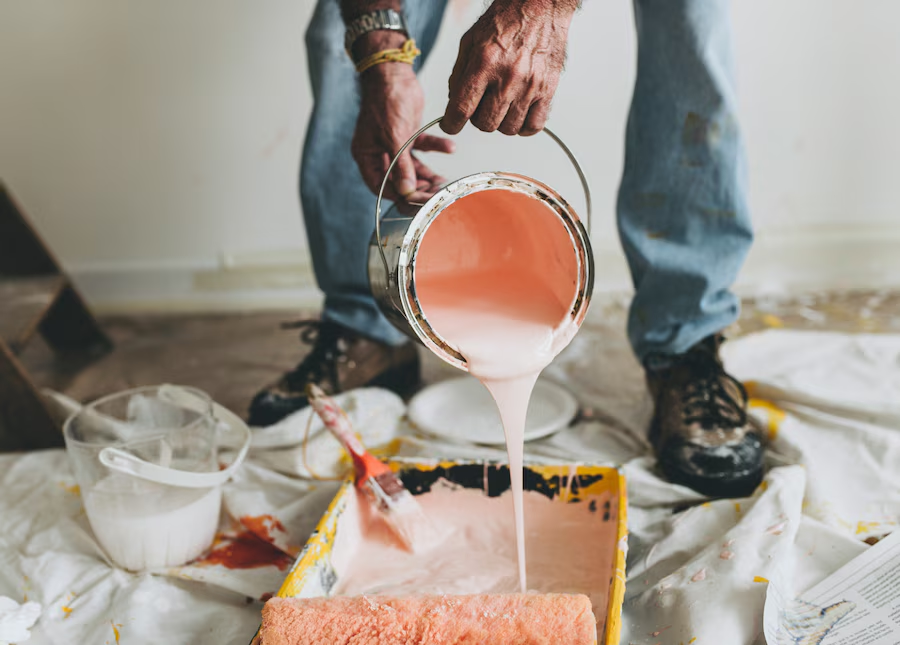Interior design thrives on cohesion and mood, and monochrome painting is one of the most refined ways to evoke both. Whether the palette leans toward striking contrasts or subtle tonal shifts, monochrome schemes have earned their place in modern design. For homeowners and designers aiming for sophistication and unity, the right painting service makes all the difference. At Precision Painting, each stroke serves a purpose—refining space, reflecting personality, and enhancing architectural detail through expertly curated monochromatic palettes.

What Makes Monochrome Painting So Effective?
Monochrome painting doesn’t mean dull or lifeless. It’s the deliberate use of varying shades within a single color family to create visual rhythm, emotional balance, and spatial clarity. Whether your tone of choice is stormy charcoal, whisper-soft ivory, or serene navy, a skilled application transforms walls into statements.
Color psychology plays a big part, too. Cool blues soothe, warm greys ground, and deep greens relax. Experts weigh in on hue selection with purpose—making decisions based not only on visual impact but also the atmosphere a room demands.
The Architecture of Tone: Picking the Right Hue Family
An effective monochrome scheme begins with hue selection. Professionals analyze light sources, room function, and ceiling height before making tonal choices. For instance:
-
Soft Whites: Ideal for smaller rooms or where natural light is abundant. It gives an ethereal, expanded feeling.
-
Charcoal or Deep Navy: Perfect for large, well-lit spaces or those intended for evening use, such as dining rooms or studies.
-
Earthy Terracotta or Clay: Works beautifully in transitional spaces like hallways, giving warmth without overwhelming.
Choosing a monochrome palette doesn’t mean a single shade repeated everywhere. It’s about applying light, mid, and dark tones of the same hue to different surfaces—walls, trims, ceilings, and built-in furniture.
Where Experts Apply Monochrome Best?
Some of the most effective uses of monochrome are found in high-traffic and functional areas. Experts have refined strategies for using tone to manipulate perception, highlight architectural features, or hide imperfections.
Living Room
A monochrome living room can feel calm, inviting, and elevated. Layering light and mid-tones with matte finishes creates soft transitions across walls and the ceiling. Incorporating darker shades on built-in bookcases or baseboards adds grounding contrast without introducing new colors.
Bedroom
Designers often lean toward low-saturation hues—such as dusty rose, sage, or dove grey—for monochrome bedrooms. These colors encourage relaxation and give depth without harshness. Accent walls painted in a slightly deeper tone of the same color family can frame the bed or highlight architectural features like alcoves or paneling.
Kitchen
While often dominated by cabinetry and counters, walls in a kitchen can still carry tonal elegance. Using semi-gloss finishes for easier maintenance, painters might select the mid-tone of a monochrome scheme to complement natural wood, tile, or stone accents.
Expert Tips to Maximize Monochrome Impact
Creating harmony in a single-color scheme takes precision. Here’s how experts ensure a room feels dynamic, not flat:
-
Use varied sheens: Mixing matte on walls with satin on trim creates subtle dimensional changes.
-
Texture integration: Wood grain, fabric wall panels, or textured paint can introduce variation within a single color.
-
Accents matter: Monochrome doesn’t exclude metal finishes, glass, or wood—these act as neutrals within the palette.
-
Ceiling contrast: A slightly lighter or darker tone overhead defines the space without disrupting the palette.
Trending Monochrome Palettes in 2025
Interior professionals continue pushing boundaries with monochrome, selecting bolder and more unconventional hues. These palettes are gaining attention for their versatility:
-
Moss Green Spectrum: From pale eucalyptus to deep forest tones, this palette brings a calming, organic vibe.
-
Midnight Blue Variations: Luxurious, dramatic, and surprisingly adaptable to both classic and modern decor.
-
Clay and Rust Family: Earthy yet refined, this palette works well in transitional interiors and open-plan homes.
-
Warm Grey Gradient: A staple in minimal design, perfect for Scandinavian or industrial-inspired interiors.
-
Lilac and Lavender Tones: Soft yet contemporary, ideal for creative spaces and bedrooms.
Expert-Approved Do’s and Don’ts
Do:
-
Test paint swatches under both natural and artificial light.
-
Paint samples on at least three wall areas before finalizing.
-
Pair walls and trims in slightly different tones for contrast.
Don’t:
-
Assume one paint finish works for all surfaces.
-
Overuse white as a “safe contrast”; it often disrupts the intended flow.
-
Forget about ceilings—they’re the fifth wall in any room.
Layering with Monochrome: A Strategic Approach
Professionals often treat a space like a painting itself—foreground, background, and focal points. In monochrome painting, this layering is essential. A successful interior balances intensity and restraint. For instance:
-
Background Base (walls): Mid-tone, matte finish for sophistication.
-
Secondary Accents (trim, ceiling): Slightly lighter or darker variation for contrast.
-
Visual Anchors (doors, built-ins): Deepest tone of the palette, often in satin or gloss for emphasis.
This methodology ensures the room doesn’t feel one-dimensional.
Why Interior Designers Love Monochrome for Small Spaces?
Smaller rooms benefit from a unified color story. It blurs boundaries, making walls and furniture feel cohesive rather than segmented. Experts often avoid high-contrast trims in tight quarters, choosing instead to wrap the entire space—walls, doors, and baseboards—in a single tone. This technique elongates wall lines and softens corners.
Expert-Favored Paint Pairings
Here are expert-endorsed tone combinations within individual color families:
Warm Greys:
-
Pale Silver (walls)
-
Stone Grey (trims)
-
Graphite (doors or built-ins)
Dusty Blues:
-
Sky Mist (walls)
-
Fog Blue (ceiling)
-
Ink Slate (furniture)
Soft Terracotta:
-
Clay Blush (walls)
-
Burnt Peach (accents)
-
Reddish Brown (built-ins)
Natural Greens:
-
Pale Sage (walls)
-
Olive Leaf (trims)
-
Forest Deep (focal point wall)
Elegant Beiges:
-
Vanilla Cream (walls)
-
Almond Beige (ceiling)
-
Caramel Tan (door frame or custom shelves)
The Power of Paint Finish in Monochrome Design
Gloss, satin, eggshell, and matte finishes can all exist in one monochrome scheme. Painters strategically assign finishes based on:
-
Functionality: High-traffic areas get semi-gloss or satin for durability.
-
Light reflection: Matte walls absorb more light, giving depth, while satin reflects subtly to draw attention.
-
Tactile variety: Even when color remains constant, changing the finish introduces complexity.
Professional painters layer finishes to mimic shadow and light interaction. This technique prevents dullness in single-hue rooms.
Artistic Touches: Using Monochrome for Murals and Patterns
Not every monochrome application has to be solid. Some interior painters and artists incorporate tone-on-tone patterns like:
-
Stripes or chevrons in two sheens of the same color
-
Faux paneling using raised stencils in a darker tone
-
Geometric shapes painted in close hues to create movement
-
Soft gradient ombré walls transitioning from floor to ceiling
These nuanced designs preserve the monochrome theme while offering focal points.
Monochrome Beyond Walls
Professionals often expand the monochrome palette to architectural and decor elements, such as:
-
Window frames painted in deeper hues
-
Fireplaces coated in mid-tones to merge with the walls
-
Radiators, vents, or shelving units are treated as part of the wall scheme
-
Painted floors in matching or offset tones for continuity
The goal is total immersion, where everything aligns with the core palette for a curated, intentional appearance.
How to Maintain a Monochrome Room?
Maintenance is as much a part of the design process as application. Interior specialists recommend:
-
Choosing washable finishes for kitchens and children’s areas
-
Regular dusting to avoid buildup on darker tones
-
Using matching paint for quick touch-ups rather than patchwork from a different batch
With the right finish and paint quality, monochrome rooms retain elegance even under daily use.
Why Choose Precision Painting?
Precision Painting understands that painting is more than application—it’s visual storytelling. Our team works with interior designers, architects, and homeowners to ensure each monochrome project is executed with harmony, style, and technical finesse. From color consultation to final stroke, our process centers around your space and how you want it to feel. When you choose Precision Painting, you choose detail, discipline, and design-led transformation—wall by wall, shade by shade.

